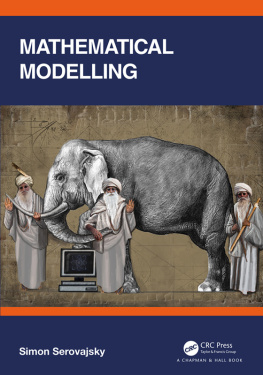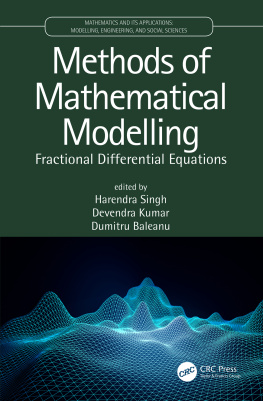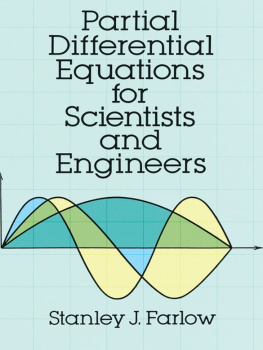Introduction to Environmental Modeling
The textbook presents an understanding of how basic physical descriptions can be translated into mathematical analogues that provide an opportunity to investigate environmental processes. Examples come from a range of hydrologic, atmospheric, and geophysical modeling problems. The emphasis is on simple examples and calculations that add to understanding. The book provides a sense for the meaning of mathematical expressions, a physical feel for their relations to the processes that they describe, and confidence in working with mathematical solutions.
Addressing environmental modeling problems from a scientific basis requires integration of physical understanding, mathematical skill, courage in making reasonable approximations, and transparency in identifying strengths, weaknesses, applicability, and limitations of the models formulated, employed, and solved. From this perspective, embarking on environmental modeling requires a student to depart from the familiar comforts of well-defined problems for which there is a well-defined solution. Students need to learn how to tackle often incompletely-defined environmental problems in an effort to understand the unknown elements of the past, present, or future and to learn where further studies are needed to increase understanding. The need to approximate, to span mathematics, science, and computational methods, to critique all elements of an analysis, and to admit limitations on what has been accomplished, all contribute to making environmental modeling an exciting, yet sometimes uncomfortable, activity. The goal of this book, in essence, is to present the timeless basic physical and mathematical principles and philosophy of environmental modeling, often to students who need to be taught how to think in a different way than they would for the average more narrowly-defined engineering or physics problem. Minimum prerequisites for the student reader (for any realistic modeling) include a knowledge of calculus through differential equations, but the book provides the mathematical and physical tools needed as the occasion arises.
Dr. William G. Gray holds a Ph.D. in chemical engineering from Princeton University. He has held full time faculty positions in civil engineering at Princeton and the University of Notre Dame and in environmental engineering and the Curriculum for the Environment and Ecology at the University of North Carolina (UNC), Chapel Hill. He has received teaching awards at Notre Dame and UNC. Dr. Gray is a Fellow of the American Geophysical Union, Distinguished Engineering Alumnus of the University of California at Davis, a Fulbright Scholar, and a Langbein Lecturer of the Hydrology section of the American Geophysical Union. He was editor of Advances in Water Resources for a dozen years and editor of Water Resources Research for four years. He is the author of approximately 140 articles in refereed journals and is a co-author of eight books.
Dr. Genetha A. Gray is a data scientist in the Talent Intelligence and Analytics organization at Intel where she analyzes talent supply chains and models career progression. Before joining Intel in 2014, Genetha spent 12 years at Sandia National Labs. There, she worked on problems related to the electrical and mechanical engineering of systems, the storage of nuclear waste, groundwater remediation, cyber security, and energy. She has a Ph.D. in Computational and Applied Mathematics from Rice University and specializes in analytics, optimization, data fusion, model validation, and uncertainty quantification. She has co-authored more than 25 research publications and given more than 60 presentations.
Introduction to Environmental Modeling
WILLIAM G. GRAY
University of North Carolina at Chapel Hill, USA
GENETHA A. GRAY
Intel Corporation, USA

University Printing House, Cambridge CB2 8BS, United Kingdom
One Liberty Plaza, 20th Floor, New York, NY 10006, USA
477 Williamstown Road, Port Melbourne, VIC 3207, Australia
4843/24, 2nd Floor, Ansari Road, Daryaganj, Delhi 110002, India
79 Anson Road, #0604/06, Singapore 079906
Cambridge University Press is part of the University of Cambridge.
It furthers the Universitys mission by disseminating knowledge in the pursuit of education, learning, and research at the highest international levels of excellence.
www.cambridge.org
Information on this title: www.cambridge.org/9781107571693
Cambridge University Press 2017
This publication is in copyright. Subject to statutory exception and to the provisions of relevant collective licensing agreements, no reproduction of any part may take place without the written permission of Cambridge University Press.
First published 2017
Printed in the United States of America by Sheridan Books, Inc.
A catalog record for this publication is available from the British Library.
ISBN 978-1-107-57169-3
Additional resources for this publication at www.cambridge.org/9781107571693
Cambridge University Press has no responsibility for the persistence or accuracy of URLs for external or third-party Internet Web sites referred to in this publication and does not guarantee that any content on such Web sites is, or will remain, accurate or appropriate.
To the next generation of modelers,
Charlotte, Ben, Lucy, Gray, and Iris;
and to those who gave them life, love them,
and nurture their environment.
Contents
Figures
Preface
The possibility of using a computer to predict the physical, chemical, and biological responses of environmental systems is an exciting notion that attracts student interest. The elements and processes of environmental modeling, however, are in many ways foreign to the kind of thinking that young investigators exercise during their educational experience. Modeling is inexact, requires physical insight, makes use of mathematics that expresses physical concepts, and is subject to revision and continuing study in light of data and observed system behavior. In developing their scientific background, students often see solving problems of physics as grabbing the right equation for the job. Solution of mathematical equations likewise involves identifying and applying the right techniques. Mathematics and physics books for undergraduates only present problems that are fully specified, can be solved, and that have a single answer. Many of those answers are given in the back of the book. Thus work on a problem is reduced to shooting for a known target solution or at least finding the direct path to the only possible answer. Environmental questions, on the other hand, involve problems that an investigator must define in terms of their component elements to find answers that were previously unknown. Formulation of equations requires information about time and spatial scales. Information that would make even simple models solvable is often lacking. The absence of an a priori answer requires that the modeler not only propose a model and its results but also be the harshest critic of the inadequacies of the model. This dual role requires that the modeler be well versed in fundamental processes and in how descriptions of those fundamental processes can be applied to particular environmental problems of interest. Learning to do this requires much more than a semester or a single book of exposure; it requires experience, success, failure, time, insight, and patience.












